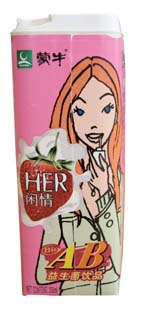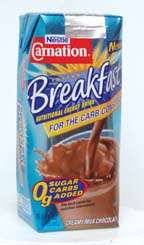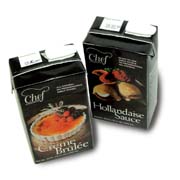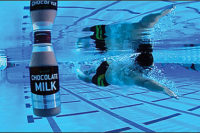
"What this means is that many successful products going forward are likely to deliver on two or more of those drivers," says Marie Benedix, manager, premium dairy, Tetra Pak. "For instance, there will be meal replacement solutions that are all-natural, grab-and-go beverages that are simultaneously good for you. Mood enhancement may involve products that give you energy, de-stress you or give you an emotional pick-me-up-all depending on occasion. And the strongest new mood-enhancing products are likely to combine the mood effect with being convenient, healthy or indulgent."
Linda Gilbert, president, HealthFocus International, St. Petersburg, Fla., says, "The pursuit of health today is about feeling good and achieving a high level of well-being. Shoppers are reconciling their lifestyle situations, health conditions and dietary choices to satisfy their expectations of themselves. They are making a conscious choice to be happy and to feel good about themselves, regardless of the situation.
"Healthy eating no longer means just avoiding nutritionally undesirable foods and ingredients. It means balancing healthy with less healthy choices," Gilbert concludes. "With milk as a base, dairy marketers are well poised to help shoppers balance the healthy and the indulgent, the nutritious and the fun, the new and the familiar choices."
The good news for dairy marketers is that dairy products are already intuitively associated with some of the four drivers. Consumers recognize the healthful halo milk possesses. In addition, dairy foods have excellent emotional equities. Dairy is associated with being calming, comforting, energizing, indulging and satiating.
For dairy companies to capitalize on today's trends, consumers' beliefs and dairy's equities, they must think beyond milk. With its healthful image, milk can form the basis of new foods and beverages that meet the complex needs and desires of today's consumers. The trick lies in formulating a relevant, attractive, simple message that communicates how the product benefits the consumer, how it provides a solution in the person's life.
At the same time, it's important not to overwhelm consumers with too many new things or too complex a proposition all in one go.
"The key to innovation is to start with something consumers already know, and then add a twist to it," adds Benedix. "For instance, if consumers are familiar with milk and juice for breakfast, a new breakfast juice-milk drink that puts it all together may not be a big stretch, especially if it's in a convenient form that suits their lifestyle."
Getting consumers to accept a new product concept does not occur overnight. "Once consumers accept a juice-milk drink, the next step could be to take that product and add something new, perhaps fiber, probiotics or extra protein," says Benedix. "If you innovate using this step-by-step approach, most likely you will eventually be marketing products that are quite sophisticated, without having lost or overwhelmed consumers in any one step along the way."
The Milk Processor Education Program's (MilkPEP's) Fluid Milk Strategic Thinking Initiative (FMSTI) is working with Beverage Marketing Corp., New York, to provide milk marketers with intelligence on how to add profitable growth to the fluid dairy category. Beverage Marketing has identified a variety of initiatives including optimizing consumer reach of dairy beverages, but more importantly, meeting unsatisfied consumer needs through the development of new products and packages. Indeed, the future of dairy is contingent on innovation.
Sidebar: Four Mega Drivers of New Food Products
Convenience-On-the-go, harried lifestyles require products that travel well.Health-More nutritionally aware, consumers are rejecting beverages that provide
empty calories.
Mood Enhancement-A stressful, complex life needs little boosts throughout the day.
Self Indulgence-And, in the end, it is all about pleasure.

Sidebar: New Products, New Needs, New Places
Dairy marketers around the world are capitalizing on the four mega drivers of product innovation. The result is not only new products based on new ingredients and technologies, but also new usage occasions and venues. For example, meal replacement beverages such as breakfast drinks based on milk and loaded with protein, fiber, vitamins and minerals appeal to individuals rushing out the door to work in the morning."People are becoming more and more health conscious and are willing to pay a little bit more for convenience and perceived benefit," says Suzanne Perry, group product manager, PB Foods Ltd., Perth, Western Australia.
Annikka Herme, marketing manager at Valio, Finland, adds, "Normal milk consumption is decreasing all the time. By developing and launching new products with added value, dairy products are an alternative to other beverages."
Using proprietary technology, Valio has been very successful with its lactose-free milk line, which appeals to consumers who want to reap the nutritional benefits of consuming milk, but cannot manage the inherent lactose. "Other successful value-added dairy beverages are calcium-enriched milk, probiotic milk, flavored milk drinks, juice and milk drinks, whey-based juices and, of course, the new functional ‘shots' for different health benefits," says Herme. "In addition to the nutritional benefits of the product, the shelflife and the package itself play an important role. For on-the-go lifestyles, there is a need for convenient, easy-to-handle packages. Another important factor is the right package size. The consumer need for portion packs is increasing all the time."

Dallas-based Dean Foods Co.'s Horizon Organic recognized an unmet need in value-added single-serve milk and responded accordingly. The company markets a variety of flavored milks in Tetra Prisma® Aseptic containers, rendering the product available for nationwide distribution without costly refrigeration. Multi-packs of the chocolate flavor are also sold in club stores, which helps parents have milk on hand for kids' lunches. Horizon Organic is able to offer more unique and sophisticated flavor options because of the shelf-stable concept. Fortified with vitamins and minerals and certified organic, the product appeals to the convenient, health and self-indulging trends.
Indulgence, indeed, is a driver for innovation. Culinary Concepts Inc., Orlando, Fla., collaborated with Tetra Pak to market two of its products (Hollandaise sauce and Crème Brûlée) to gourmet restaurants. Such custom-made, gourmet, convenience products ensure consistent quality of the finished meal while saving space, preparation time and cost for restaurants. The package protects the delicate products' original quality, flavor and characteristics. Chefs appreciate Culinary Concept's efforts. Perhaps consumers will too, if the product becomes available in retail stores.
There are plenty of opportunities in dairy once you take a new look at today's consumers' needs. Dairy can be healthy and indulgent, nutritious and fun, and new and familiar.

